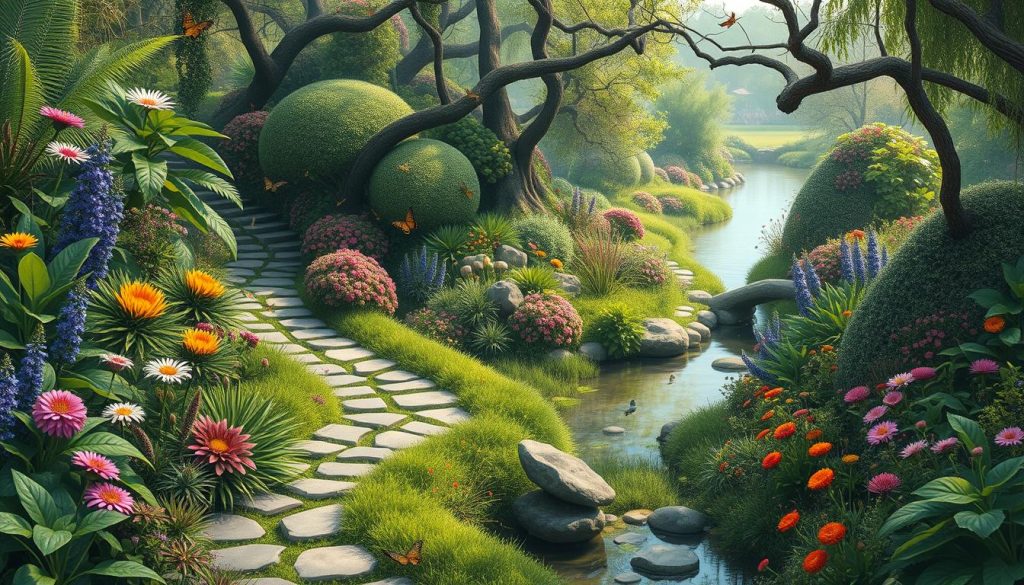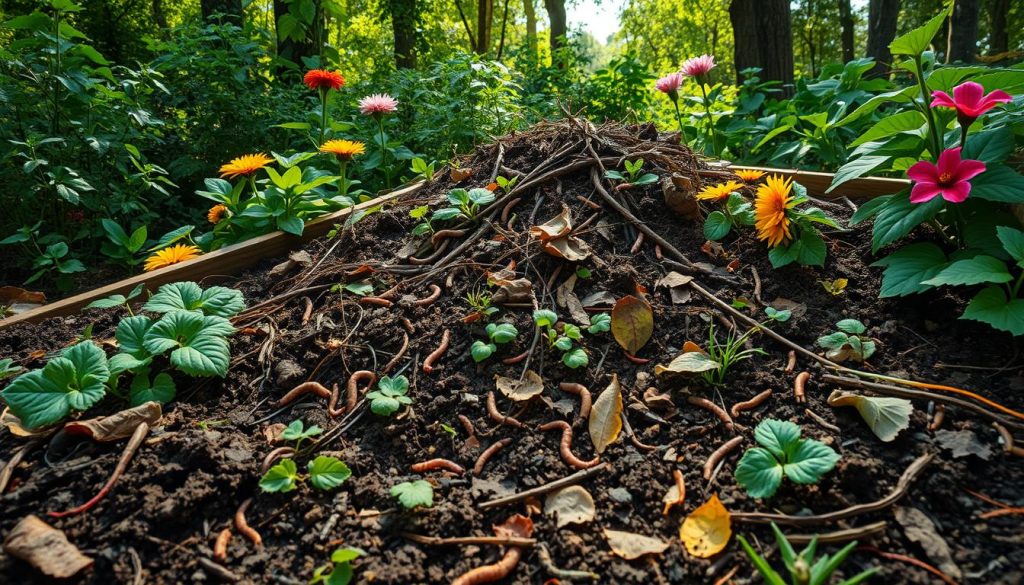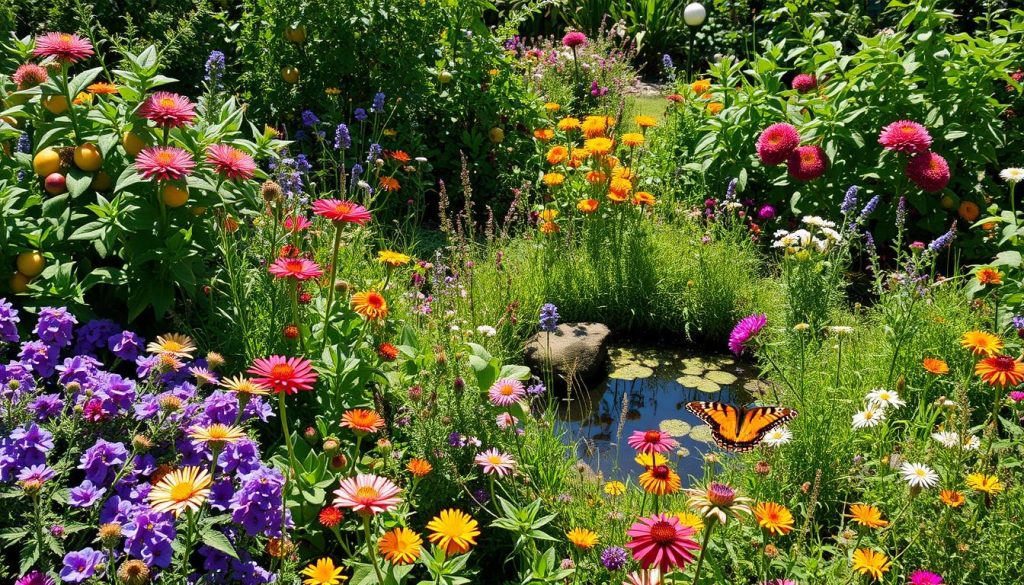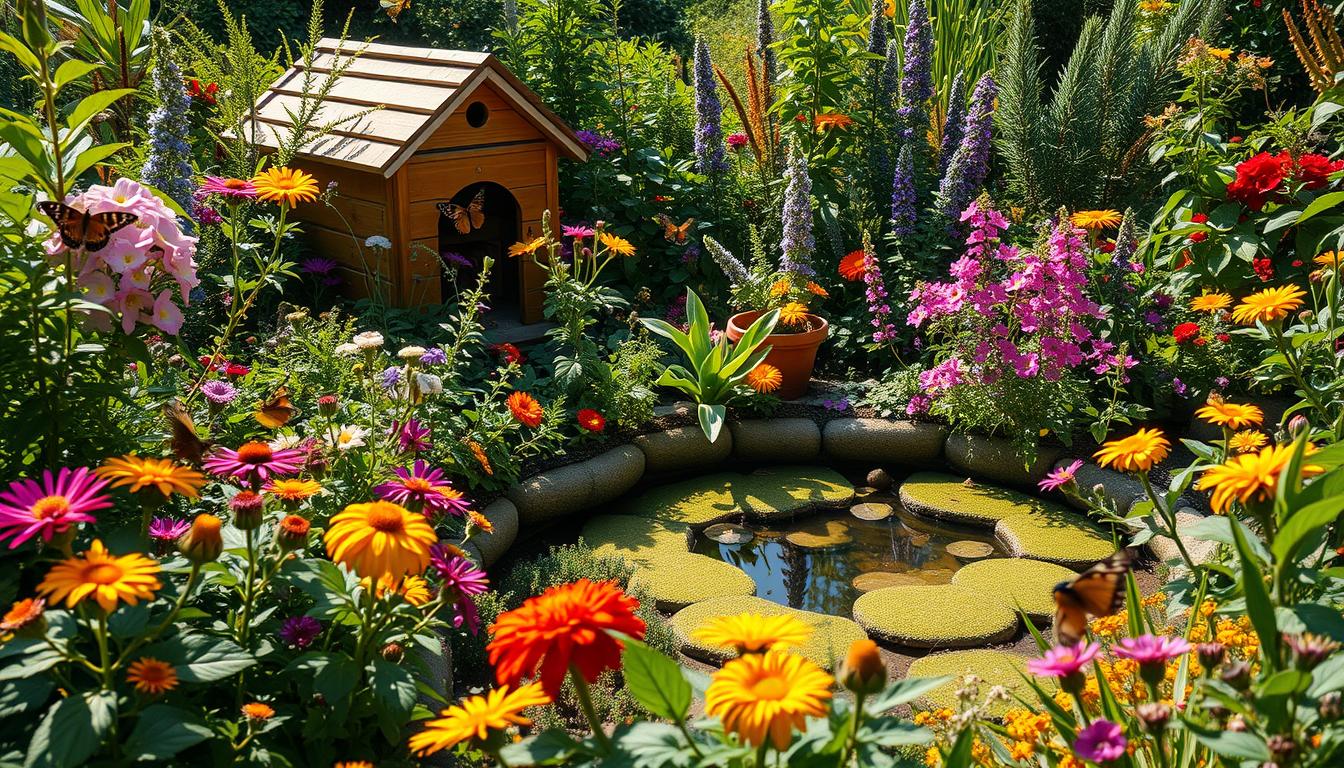I’ve always wanted my garden to be more than just flowers and veggies. I aim to turn my backyard into a home for local wildlife. Organic gardening is key to this goal.
Eco-friendly gardening is more than a trend; it’s a way to help nature. By avoiding harmful chemicals and using organic methods, my garden has become a haven for birds, bees, and butterflies. It’s incredible how a few changes can make such a big impact!
In this article, I’ll share my journey into organic gardening for wildlife. We’ll look at how to pick the right plants and create cozy habitats. Our goal is to make our gardens welcoming to wildlife while keeping them beautiful and sustainable. Are you ready to help nurture nature? Let’s start!
Understanding Organic Gardening and Its Benefits
Organic gardening for wildlife has become a big part of my backyard. It’s more than just growing plants. It’s about caring for all life forms.
What is Organic Gardening?
Organic gardening means no synthetic pesticides or fertilizers. I use natural ways to keep the soil healthy and control pests. This makes my garden a safe place for wildlife and helps with biodiversity.
Why Choose Organic Practices for Wildlife?
Organic gardening keeps my garden free from toxins. This lets birds, bees, and butterflies live without harm. The soil is full of life, supporting a wide range of insects and microorganisms.
The Connection Between Organic Gardening and Biodiversity
Organic gardening really boosts biodiversity. My garden is now a home for many species, from tiny soil bacteria to birds. This variety makes my garden strong against pests and diseases.
| Organic Gardening Practice | Benefit to Wildlife | Impact on Biodiversity |
|---|---|---|
| Composting | Provides food for soil organisms | Increases variety of soil life |
| Native plant cultivation | Offers familiar food sources | Supports local insect populations |
| No synthetic pesticides | Protects beneficial insects | Maintains natural predator-prey balance |
Creating Wildlife-Friendly Spaces
Turning my garden into a wildlife haven is rewarding and fun. By designing spaces for different species, I’ve seen a big increase in backyard biodiversity.
Designing Your Garden for Different Species
I plan my garden with various creatures in mind. I add dense shrubs for birds, open areas for butterflies, and rock piles for lizards. This variety makes a rich ecosystem that supports many life forms.
Choosing Native Plants to Attract Wildlife
Native plants are key to wildlife habitats. They fit local conditions and offer food and shelter for native animals. I’ve planted milkweed for monarchs, coneflowers for goldfinches, and oak trees for many species. These plants are not only beautiful but also support wildlife all year.
| Native Plant | Region | Wildlife Attracted |
|---|---|---|
| Milkweed | Midwest | Monarch butterflies |
| Coneflower | Northeast | Goldfinches, bees |
| Oak | Nationwide | Birds, squirrels, insects |
Incorporating Water Features for Wildlife
Water attracts wildlife. I’ve added a small pond for frogs and dragonflies. Even a simple birdbath brings many birds. These water sources are vital for drinking and bathing, especially in hot summers.

By using thoughtful design, native plants, and water features, I’ve made a thriving wildlife habitat in my garden. It’s a joy to see nature right outside my window.
Essential Organic Gardening Practices
Organic gardening is a great way to support wildlife and create a thriving ecosystem. I’ve discovered some key practices that make a big difference in my garden. Let’s explore these methods together.
Composting for Soil Health
Composting is the heart of my organic garden. I mix kitchen scraps, yard waste, and fallen leaves to create nutrient-rich soil. This natural process feeds my plants and attracts beneficial organisms.
To start composting, I use a bin or designate a corner of my yard. I layer green and brown materials, turning the pile every few weeks. In a few months, I have dark, crumbly compost ready to nourish my garden.

Natural Pest Control Methods I Use
I rely on integrated pest management to keep bugs in check without harsh chemicals. Companion planting is my go-to strategy. I plant marigolds near my tomatoes to repel pests, and nasturtiums to attract aphids away from my veggies.
I also encourage beneficial insects like ladybugs and praying mantises by providing shelter and food sources. When needed, I use organic sprays made from neem oil or garlic to deter persistent pests.
Soil Management Techniques That Support Wildlife
Healthy soil is the foundation of a wildlife-friendly garden. I use mulch to retain moisture and suppress weeds. Planting cover crops like clover during off-seasons helps prevent erosion and adds nutrients to the soil.
I avoid tilling to protect soil structure and beneficial microorganisms. These practices create a rich environment that supports plants and attracts a variety of wildlife to my garden.
The Role of Pollinators in My Garden
In my organic garden, pollinators are crucial. They help my plants grow well and give me lots of food. I’ve found that using native plants in my garden is the best way to attract these important visitors.
Attracting Bees: The Best Plants
Bees love my garden because of the many flowers I have. Their favorites include:
- Coneflowers
- Black-eyed Susans
- Lavender
- Bee balm
These plants give bees nectar all season long. This keeps them happy and healthy.
Butterflies and Moths: Creating a Haven
To draw in butterflies and moths, I’ve added special plants to my garden. Milkweed is a must for monarchs, while fennel and dill attract swallowtails. I also have small mud puddles for butterflies to get minerals.
Hummingbirds: Planting for Attraction
Hummingbirds add joy to my garden. They love tubular flowers like trumpet honeysuckle and cardinal flower. I plant these in groups so they can easily find food. My garden is now full of life, showing that organic gardening and caring for pollinators work together.
| Pollinator | Favorite Native Plants | Beneficial Garden Features |
|---|---|---|
| Bees | Coneflowers, Lavender | Shallow water sources |
| Butterflies | Milkweed, Fennel | Mud puddles |
| Hummingbirds | Trumpet Honeysuckle, Cardinal Flower | Nectar feeders |
Implementing Wildlife Habitats
Creating wildlife habitats in your garden is rewarding. It supports local ecosystems. Sustainable landscaping turns any outdoor space into a thriving sanctuary for creatures.

Building Birdhouses and Nesting Boxes
I enjoy attracting birds to my garden. Building birdhouses and nesting boxes is rewarding. For bluebirds, use boxes with 1.5-inch entrance holes 5 feet high. Wrens like smaller openings, about 1 inch in diameter.
Remember to clean out old nests each spring. This prevents parasites.
Insect Hotels: A Shelter for Bugs
Insect hotels are key for sustainable landscaping. I make mine from hollow bamboo stems, pine cones, and bark. These provide safe spaces for beneficial insects like solitary bees and ladybugs.
Place them near flowering plants for a steady food source. This helps these important pollinators.
Creating Brush Piles for Small Mammals
Brush piles are simple yet effective. I stack fallen branches and logs in a corner. This creates a cozy retreat for rabbits, chipmunks, and reptiles.
This natural shelter protects them from predators and harsh weather. It’s amazing to see these piles become hubs of activity in my garden.
By adding these features, I’ve seen a big increase in biodiversity. My garden buzzes with life all year. It shows that small changes can make a big difference for local wildlife.
The Importance of Food Sources
In my organic gardening for wildlife journey, I’ve learned that offering diverse food sources is crucial. It’s not just about growing plants; it’s about creating a thriving ecosystem. Let’s explore how we can turn our gardens into wildlife-friendly buffets.
Growing Berry-Producing Plants
I love planting berry bushes in my garden. They’re not only delicious for us but also crucial for birds and small mammals. Native species like elderberry, blackberry, and serviceberry offer nutritious berries throughout different seasons. I’ve noticed an increase in bird activity since adding these to my eco-friendly gardening setup.
Herb Gardens: Attracting Beneficial Insects
My herb garden is a buzzing hub of activity. Basil, lavender, and mint are favorites among bees and butterflies. These herbs not only add flavor to my meals but also contribute to pest control and pollination. It’s amazing to see how a small patch of herbs can boost garden biodiversity.
Vegetables that Serve as Wildlife Food
I’ve learned to share my vegetable harvest with garden visitors. Leaving some extra tomatoes, squash, and leafy greens for wildlife has created a more balanced garden ecosystem. I now plant extra crops specifically for my animal friends, which aligns perfectly with my organic gardening for wildlife approach.
| Plant Type | Examples | Wildlife Attracted |
|---|---|---|
| Berry Plants | Elderberry, Blackberry, Serviceberry | Birds, Small Mammals |
| Herbs | Basil, Lavender, Mint | Bees, Butterflies |
| Vegetables | Tomatoes, Squash, Leafy Greens | Various Small Animals |

By providing these diverse food sources, I’ve created a garden that’s not just beautiful, but also supports a wide range of wildlife. It’s rewarding to see how these simple choices in organic gardening for wildlife can make such a big difference.
Water Sources for Wildlife
Providing water is key for a thriving wildlife garden. I’ve added different water features to attract many creatures. This has also boosted my xeriscaping efforts. Let’s look at some ways to add water to your garden.
Establishing a Birdbath
A birdbath can really help. I put mine in a shady area, away from bushes. It’s important to keep it clean and filled with fresh water. I also added a small fountain to attract more birds.
Constructing a Small Pond
Creating a pond was rewarding. I chose a sunny spot and used a pre-formed liner for easy setup. Adding native plants made it a natural home for frogs, dragonflies, and ducks.
Rain Gardens: Managing Water for Wildlife
Rain gardens are great for managing water and supporting wildlife. I planted mine with native species that do well in wet and dry conditions. This fits well with xeriscaping, saving water and making a beautiful space.
| Water Feature | Benefits | Maintenance |
|---|---|---|
| Birdbath | Attracts birds, easy to install | Regular cleaning, daily refills |
| Small Pond | Supports diverse wildlife, adds beauty | Seasonal cleaning, plant care |
| Rain Garden | Manages runoff, drought-resistant | Occasional weeding, minimal watering |
These water features have made my garden a lively ecosystem. It supports local wildlife and is water-wise. It’s amazing how these simple steps can turn a garden into a wildlife haven.
Seasonal Changes and Their Impact
As a gardener, I focus on sustainable landscaping and biodiversity. Each season brings its own set of challenges and chances. My garden changes all year, offering a lively home for wildlife.
Preparing My Garden for Each Season
In spring, I plant native flowers and veggies. Summer is for upkeep and picking what’s ripe. Fall is for gathering seeds and getting ready for winter. Winter, I let some spots untouched for animal shelter.
Seasonal Food Sources for Wildlife
I make sure my garden has food all year. Spring has fresh buds and bugs. Summer offers fruits and berries. Fall gives nuts and seeds. Winter, I leave dried seeds and berries for birds and small animals.
Wildlife Behavior Throughout the Year
Wildlife behavior changes with the seasons. Spring is for breeding and building nests. Summer is for young ones to explore. Fall is for getting ready for winter. Winter, some animals sleep while others find food and shelter in my garden.
By adjusting my gardening to these seasonal patterns, I help with biodiversity. My backyard becomes a lively ecosystem.
Engaging the Community in Organic Gardening
Sharing eco-friendly gardening tips is my passion. I enjoy telling others about creating spaces for wildlife. Let’s look at ways to get the community involved in organic gardening.
Hosting Workshops on Wildlife Gardening
I host workshops in my garden to teach organic gardening. People learn about habitats, native plants, and natural pest control. These workshops help gardeners connect and share ideas.
Collaborating with Local Garden Clubs
Working with garden clubs is rewarding. We do projects like butterfly gardens and native plant sales. These efforts spread the word about organic gardening for wildlife.
Sharing My Experiences Through Social Media
Social media is great for showing off wildlife-friendly gardens. I post updates, tips, and answer questions. This online community supports eco-friendly gardening.
| Platform | Content Type | Engagement Rate |
|---|---|---|
| Photos of wildlife visitors | High | |
| YouTube | Tutorial videos | Medium |
| Live Q&A sessions | Very High |
Through different channels, I’ve seen more interest in organic gardening. It’s inspiring to see how we can all make a difference in our ecosystems.
Continuing Education in Organic Practices
Keeping up with organic gardening is key for a thriving wildlife habitat. I’ve explored many resources that have boosted my knowledge and skills.
Recommended Books and Resources
The Organic Gardener’s Handbook of Natural Pest and Disease Control” by Fern Marshall Bradley changed my gardening game. It’s full of useful tips for a balanced garden. For landscaping ideas, “The Living Landscape” by Rick Darke and Doug Tallamy is my go-to.
Local Organizations to Join
Being part of the Native Plant Society has been a game-changer. They host field trips and workshops that teach a lot about local ecosystems. Their programs have helped me create spaces that are friendly to wildlife.
Online Courses and Webinars for Growth
I took an online course on organic soil management from Oregon State University. It changed how I care for my soil. The National Wildlife Federation’s webinars have taught me a lot about landscaping that helps local wildlife. These learning opportunities keep me excited and informed about organic gardening.

